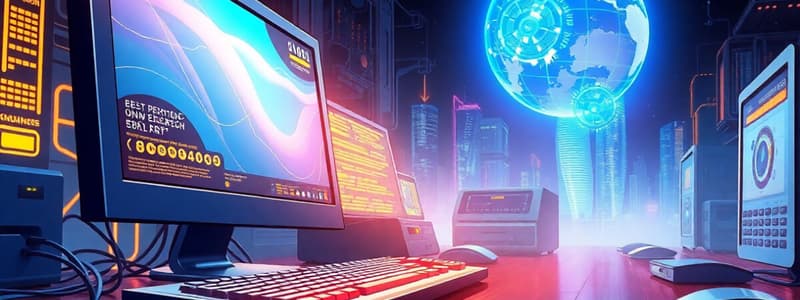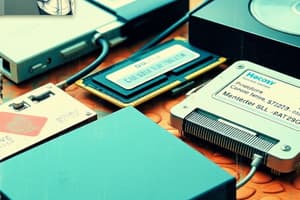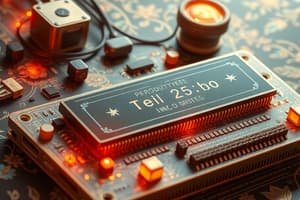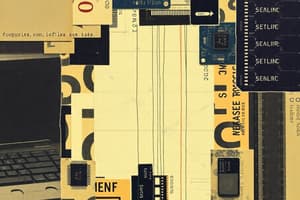Podcast
Questions and Answers
The output unit converts the data entered by the user into computer understandable form
The output unit converts the data entered by the user into computer understandable form
False (B)
A ______ monitor looks like a television and are normally used with non-portable computer systems.
A ______ monitor looks like a television and are normally used with non-portable computer systems.
CRT
Input and ______ is the raw material used as input and ______ is the processed data obtained as output of data processing.
Input and ______ is the raw material used as input and ______ is the processed data obtained as output of data processing.
Data, information
Any electronic holding place where data can be stored and retrieved later whenever required is ______
Any electronic holding place where data can be stored and retrieved later whenever required is ______
Size of the ______ memory mainly depends on the size of the address bus.
Size of the ______ memory mainly depends on the size of the address bus.
MAR stands for ______
MAR stands for ______
Optical disks are proved to be a promising random access medium for high capacity secondary storage
Optical disks are proved to be a promising random access medium for high capacity secondary storage
The tracks are divided into sectors whose size ______
The tracks are divided into sectors whose size ______
A kilobyte (KB) is 1024 byte
A kilobyte (KB) is 1024 byte
Flashcards
What is CamScanner?
What is CamScanner?
A mobile application that allows users to scan documents using their smartphone's camera.
How does CamScanner work?
How does CamScanner work?
CamScanner enables users to capture images, enhance their quality, and convert them into different file formats like PDF, JPG, and more.
How can I share documents using CamScanner?
How can I share documents using CamScanner?
CamScanner facilitates sharing scanned documents via email, cloud storage services like Dropbox or Google Drive, and social media platforms.
How can I organize my scanned documents on CamScanner?
How can I organize my scanned documents on CamScanner?
Users can organize scanned documents into folders based on themes, projects, or other criteria to ensure better organization.
Signup and view all the flashcards
What is OCR in CamScanner?
What is OCR in CamScanner?
CamScanner offers features like text recognition (OCR) that allows users to extract text from scanned images, enabling them to search or copy the content.
Signup and view all the flashcards
Can I edit my scanned documents on CamScanner?
Can I edit my scanned documents on CamScanner?
Users can annotate or markup scanned documents using CamScanner's integrated editing tools, providing a collaborative experience.
Signup and view all the flashcards
Does CamScanner support multiple languages?
Does CamScanner support multiple languages?
CamScanner supports multiple languages, ensuring accessibility for users worldwide. Users can choose to have their documents scanned in different languages.
Signup and view all the flashcards
Is CamScanner free or paid?
Is CamScanner free or paid?
CamScanner offers a free version with basic features and a paid subscription for advanced capabilities including higher-quality scans, more storage, and additional editing tools.
Signup and view all the flashcards
Can I use CamScanner on different devices?
Can I use CamScanner on different devices?
CamScanner can be used across various devices, including smartphones, tablets, and desktops, providing flexibility for scanning and managing documents.
Signup and view all the flashcards
What is the main goal of CamScanner?
What is the main goal of CamScanner?
CamScanner aims to simplify document management and sharing, making it easier for users to access and work with digital copies of paper documents.
Signup and view all the flashcardsStudy Notes
Computer Peripheral Devices
- CPU is not a peripheral device. Peripherals are devices external to the CPU.
System Unit Ports
- A port in a system unit allows data transfer between various devices and the computer.
Read-Only Memory (ROM)
- ROM is computer memory where users cannot write new information or instructions. Data is permanently stored.
Byte Definition
- A byte is a group of 8 bits.
Megabyte Conversion
- A megabyte (MB) is equal to 1024 * 1024 bytes.
Device Drivers
- Device drivers allow input or output devices to communicate with the computer system.
Computer Memory Types
- The two basic types of computer memory are primary and secondary memory.
CD-ROM
- A non-erasable CD is used to store digitized audio information.
Outputting Data
- The process of producing useful information for the user is called outputting.
Output Unit Function
- The output unit converts the data input by the user into a form understandable by the computer.
Smallest Data Unit
- The smallest unit of data in a computer is a bit.
Input Unit Function
- The input unit reads instructions and data from the outside world. It doesn't convert data into a user-friendly format.
Raw Material for Data Processing
- Data acts as the raw material used in data processing.
Computer Characteristics
- Computer characteristics include speed, accuracy, and capacity; I.Q. is not a computer characteristic.
Memory Definition
- Memory is an electronic holding place where data can be stored and accessed.
Main Memory Size
- The size of main memory is dependent on the address bus size.
Secondary Memory and the Address Bus
- Secondary memory is independent of the address bus.
Memory Address Register (MAR)
- MAR stands for Memory Address Register.
Optical Disks and Storage
- Optical disks are a promising medium for high-capacity secondary storage.
Optical Disk Technology
- The technology used in optical disks is laser beam.
Optical Disk Capacity
- The storage capacity of an optical disk is calculated by multiplying the number of sectors by the number of bytes per sector.
Disk Rotation and Radius
- Disk rotation varies inversely with the radius of the disk.
Sector Size
- Sector sizes in optical disks remain constant.
Optical Disk Access Time
- The typical range for optical disk access time is 100 to 300 milliseconds.
Laser Beam Technology and Devices
- DVDs use laser beam technology.
Bar Code Reader Function
- A bar code reader is an input device.
Supercomputers
- Supercomputers are the most powerful type of computer.
Kilobyte Definition
- A kilobyte (KB) is equal to 1024 bytes.
Memory Management
- Memory management is the process of allocating memory to programs and separating programs in memory.
Primary Storage
- Primary storage is also known as memory.
Memory Types
- SRAM, ROM, DRAM are types of memory; QRAM is not.
Logic Chip Name
- Another name for a logic chip is a microprocessor.
Binary System
- Data on computers is represented using the binary system.
Bit Function
- A bit represents a letter, digit, or special character in computer data.
Memory Capacity Units
- Memory capacity is measured in megabytes (MB).
Cache Location
- Cache memory is built into the CPU chip.
Processor Speed Measurement
- Processor speed is measured in megahertz (MHz).
Dot Pitch
- Dot pitch is the distance between pixels on a computer screen.
Screen Symbol Name
- A pictorial screen symbol that represents a computer activity is an icon.
Soft Copy Definition
- A soft copy of an image refers to showing it on a screen.
Optical Character Recognition Device
- A wand reader is an optical character recognition device.
Mark Sensing
- Mark sensing is another term for OMR (Optical Mark Recognition).
Screen Refresh Rate
- The rate of screen refreshment is called raster rate.
Studying That Suits You
Use AI to generate personalized quizzes and flashcards to suit your learning preferences.




